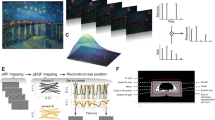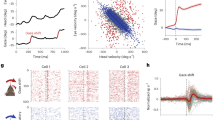Abstract
To localize objects in space, the brain needs to combine information about the position of the stimulus on the retinae with information about the location of the eyes in their orbits. Interaction between these two types of information occurs in several cortical areas1,2,3,4,5,6,7,8,9,10,11,12, but the role of the primary visual cortex (area V1) in this process has remained unclear. Here we show that, for half the cells recorded in area V1 of behaving monkeys, the classically described visual responses are strongly modulated by gaze direction. Specifically, we find that selectivity for horizontal retinal disparity—the difference in the position of a stimulus on each retina which relates to relative object distance—and for stimulus orientation may be present at a given gaze direction, but be absent or poorly expressed at another direction. Shifts in preferred disparity also occurred in several neurons. These neural changes were most often present at the beginning of the visual response, suggesting a feedforward gain control by eye position signals. Cortical neural processes for encoding information about the three-dimensional position of a stimulus in space therefore start as early as area V1.
This is a preview of subscription content, access via your institution
Access options
Subscribe to this journal
Receive 51 print issues and online access
$199.00 per year
only $3.90 per issue
Buy this article
- Purchase on Springer Link
- Instant access to full article PDF
Prices may be subject to local taxes which are calculated during checkout





Similar content being viewed by others
References
Andersen, R. A. & Mountcastle, V. M. The influence of the angle of gaze upon the excitability of the light-sensitive neurons of the posterior parietal cortex. J. Neurosci. 3, 532–548 (1983).
Andersen, R. A., Essick, G. K. & Siegel, R. M. Encoding of spatial location by posterior parietal neurons. Science 230, 456–458 (1985).
Andersen, R. A., Bracewell, R. M., Barash, S., Gnadt, J. W. & Fogassi, L. Eye position effects on visual, memory and saccade-related activity in areas LIP and 7A of macaque. J. Neurosci. 10, 1176–1196 (1990).
Squatrito, S. & Maioli, M. G. Gaze field properties of eye position neurones in areas MST and 7a of the macaque monkey. Vis. Neurosci. 13, 385–398 (1996).
Galletti, C. & Battaglini, P. P. Gaze-dependent visual neurons in area V3A of monkey prestriate cortex. J. Neurosci. 9, 1112–1125 (1989).
Galletti, C., Battaglini, P. P. & Fattori, P. Eye position influence on the parieto-occipital area PO (V6) of the macaque monkey. Eur. J. Neurosci. 7, 2486–2501 (1995).
Weyand, T. G. & Malpeli, J. G. Responses of neurons in primary visual cortex are modulated by eye position. J. Neurophysiol. 69, 2258–2260 (1993).
Guo, K. & Li, C. Y. Eye position-dependent activation of neurones in striate cortex of macaque. NeuroReport 8, 1405–1409 (1997).
Newsome, W. T., Wurtz, R. H. & Komatsu, H. Relation of cortical areas MT and MST to pursuit eye movements. II. Differentation of retinal from extraretinal inputs. J. Neurophysiol. 60, 604–644 (1988).
Duhamel, J. R., Bremmer, F., BenHamed, S. & Graf, W. Spatial invariance of visual receptive fields in parietal cortex neurons. Nature 389, 845–848 (1998).
Boussaoud, D., Barth, T. M. & Wise, S. P. Effect of gaze on apparent visual responses of monkey frontal cortex neurons. Exp. Brain. Res. 93, 423–434 (1993).
Graziano, M. S. A., Hu, X. T. & Gross, C. G. Visuospatial properties of ventral premotor cortex. J. Neurophysiol. 77, 2268–2292 (1997).
Hubel, T. & Wiesel, T. N. Receptor fields and functional architecture of monkey striate cortex. J. Physiol. (Lond.) 195, 215–243 (1968).
Barlow, H. B., Blakemore, C. D. & Pettigrew, J. D. The neural mechanism of binocular depth discrimination. J. Physiol. (Lond.) 193, 327–342 (1967).
Poggio, G. F. & Fischer, B. Binocular interaction and depth sensitivity in striate and prestriate cortex of behaving rhesus monkeys. J. Neurophysiol. 40, 1392–1407 (1977).
Trotter, Y., Celebrini, S., Stricanne, B., Thorpe, S. & Imbert, M. Modulation of neural stereoscopic processing in primate area V1 by the viewing distance. Science 257, 1279–1281 (1992).
Trotter, Y., Celebrini, S., Stricanne, B., Thorpe, S. & Imbert, M. Neural processing of stereopsis as a function of viewing distance in primate visual cortical area V1. J. Neurophysiol. 76, 2872–2885 (1996).
Ogle, K. N. in Spatial Localization Through Binocular Vision (ed. Davson, H.) 271–324 (Academic, New York, (1962).
Ogle, K. N. in The Problem of the Horopter (ed. Davson, H.) 325–348 (Academic, New York, (1962).
Morrison, L. C. Stereoscopic localization with the eyes asymmetrically converged. Am. J. Optom. Physiol. Optics 54, 556–566 (1977).
Zipser, D. & Andersen, R. A. Aback-propagation programmed network that simulates response properties of a subset of posterior parietal neurons. Nature 331, 679–684 (1988).
Zipser, K., Lamme, V. A. F. & Schiller, P. H. Contextual modulation in primary visual cortex. J. Neurosci. 16, 7376–7389 (1996).
Donaldson, I. M. L. & Dixon, R. A. Excitation of units in the lateral geniculate and contiguous nuclei of the cat by stretch of extrinsic ocular muscles. Exp. Brain Res. 38, 245–255 (1980).
Molotchnikoff, S. & Casanova, C. Reactions of the geniculate cells to extraocular proprioceptive activation in rabbits. J. Neurosci. Res. 14, 105–115 (1985).
Lal, R. & Friedlander, M. J. Gating of retinal transmission by afferent eye position and movement signals. Science 243, 93–96 (1989).
Motter, B. C. Focal attention produces spatially selective processing in visual cortical areas V1, V2, and V4 in the presence of competing stimuli. J. Neurophysiol. 70, 909–919 (1993).
Gilbert, C. D. Adult cortical dynamics. Physiol. Rev. 78, 467–485 (1998).
Lamme, V. A. F., Super, H. & Spekreijse, H. Feedforward, horizontal, and feedback processing in the visual cortex. Curr. Opin. Neurobiol. 8, 529–535 (1998).
Acknowledgements
We thank J. Bullier, Y. Frégnac and S. Thorpe for criticism of the manuscript; K.Britten for advice on various logistics; and M. Imbert for continuous support. This work was supported by the Centre National de la Recherche Scientifique.
Author information
Authors and Affiliations
Corresponding author
Rights and permissions
About this article
Cite this article
Trotter, Y., Celebrini, S. Gaze direction controls response gain in primary visual-cortex neurons. Nature 398, 239–242 (1999). https://doi.org/10.1038/18444
Received:
Accepted:
Issue Date:
DOI: https://doi.org/10.1038/18444
This article is cited by
-
Activity in primate visual cortex is minimally driven by spontaneous movements
Nature Neuroscience (2023)
-
Latency shortening with enhanced sparseness and responsiveness in V1 during active visual sensing
Scientific Reports (2022)
-
Topographic organization of eye-position dependent gain fields in human visual cortex
Nature Communications (2022)
-
An egocentric straight-ahead bias in primate’s vision
Brain Structure and Function (2021)
-
The effect of dot size in random-dot stereograms on the results of stereoacuity measurements
BMC Ophthalmology (2020)
Comments
By submitting a comment you agree to abide by our Terms and Community Guidelines. If you find something abusive or that does not comply with our terms or guidelines please flag it as inappropriate.



